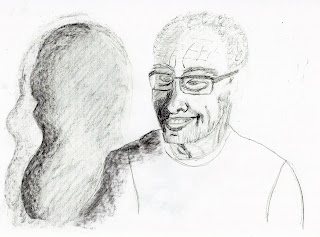I have a lovely old rose that really needed dead heading
so I gathered some petals and liquidised them.
 |
| It took this amount of petals |
 |
| to get this amount of colour |
It took a while and a bit of water but I got a lovely (if pale) lilac colour. My first sample was with the inclusions but then I sieved it and took some of them out.
I used this as a wash and then tried scrunched up peony petals using one of my spiky leaves as a stencil.
 |
| Pink peony |
The colour was more vibrant than the liquidised rose petals. I did the same with delphinium petals.
 |
| Blue delphinium |
 |
| Petal colours - showing inclusions |
I scanned it immediately because I anticipate it going brown pretty soon.
I subsequently tried scrunched up rose petals but they were just as pale as the liquidised variety.
I like the idea of using not only plant material but plant colours as well.
Inspired by this success I took my sketchbook round the garden and tried some further samples.
My paper is absorbent and soon roughed up when I applied pressure - the more watery the material I used the less that happened. Most samples stayed true to colour but the bright orange of the alstromera and the day lilies went a brown and a pink respectively. Th purples are stable and the snapdragon is brilliant, Quite literally. Predictably the tomato and the salad leaf gave lovely greens although not vibrant.
I'm going to try some smooth watercolour paper to see if it stays intact.
I began by using the sedum over the whole page and then adding salad and tomato leaf. I found with the darker colour of the salad and tomato I was able to make more controlled marks.
Getting a decent image to put on my blog was a very different task and neither of these are anything like the real thing. It is not bright green but neither is it washed out but I hope you get the idea.
I'm going to introduce some flower colours without any knowledge of what will happen when these are combined!
Scary. But this is what turned out.
 |
| Garden flowers |
I used the auto adjust on the computer and this gives me the best representation. It's not far off this time. I'm quite pleased with this but I've got my fingers crossed for stability.














































